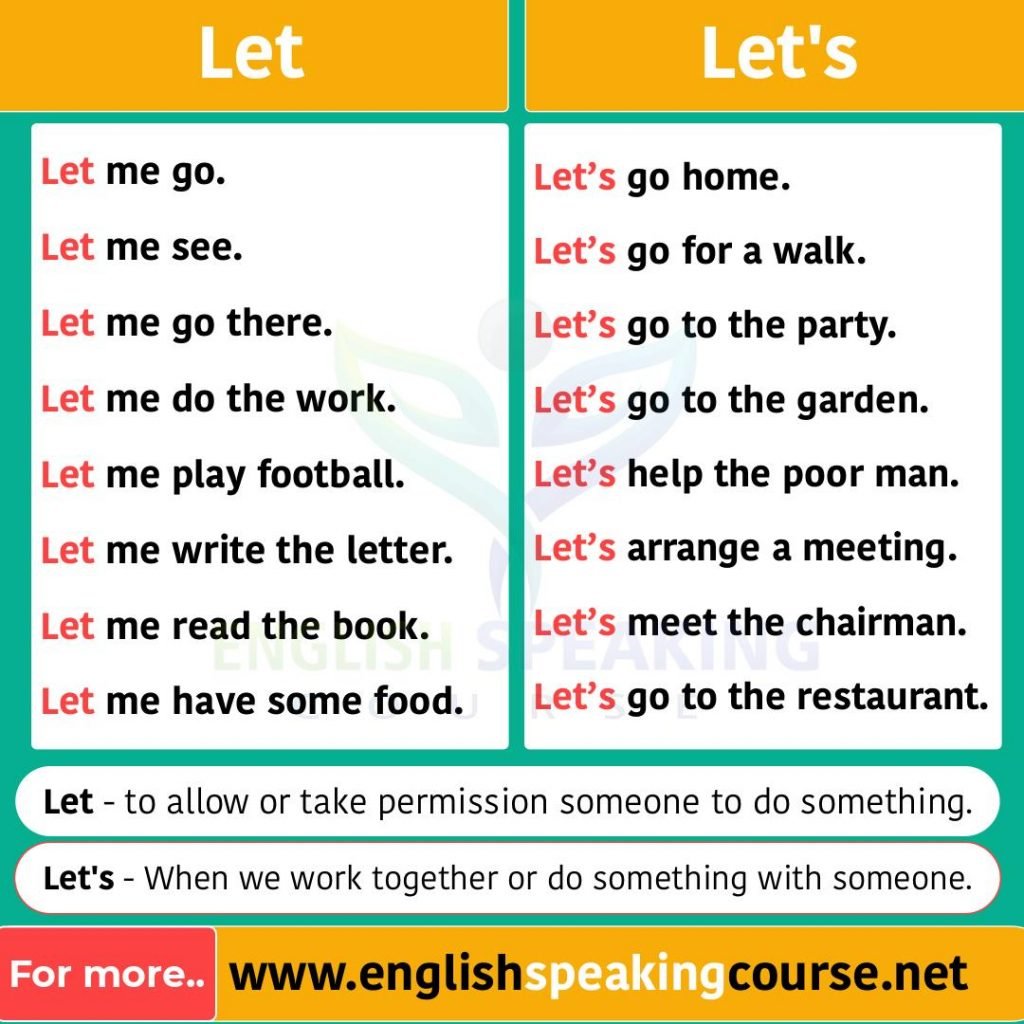Мы используем слово let, когда говорим о разрешении сделать что-то. Предложения с этим глаголом очень часто используются в разговорной речи.
Например:
«Она разрешила нам играть допоздна. Он разрешил мне взять выходной. Они разрешили ему пойти с нами».
В статье мы подробно рассмотрим, как строить все виды предложений с let, и на какие нюансы стоит обращать внимание.
Хотите заговорить на английском?
Приходите на наш бесплатный онлайн мастер-класс «Как довести английский язык до автоматизма»
Подробнее
Также Вы можете ознакомиться со всеми онлайн-курсами английского языка.
В статье вы узнаете:
- Использование let в английском языке
- Отрицательные предложения с let
- Вопросительные предложения с let
- Конструкция с let’s в английском
Утвердительные предложения с глаголом let
Глагол let переводится как «разрешить/позволить». Его мы используем, когда кто-то дает разрешение кому-то сделать что-то.
Например:
Она разрешила мне зайти.
В английском языке такие предложения строятся легко.
Для этого:
1. На первое место в предложении мы ставим главное действующее лицо – тот, кто разрешает: I, she, he, they, we.
Например:
They…
Они…
She…
Она…
2. Далее идет само действие – let.
Важно: Если на первом месте стоят she, he, то к глаголу мы добавляем окончание -s: lets.
Например:
They let…
Они разрешают…
She lets…
Она разрешает…
3. После действия идет тот человек, кому разрешают делать что-то.
Обратите внимание, как меняются наши местоимения:
I – me
you — you
he – him
she – her
they – them
we – us
Это происходит потому, что здесь местоимение не является главным действующим лицом, а является дополнением – тот, на кого направлено действие.
Например:
They let me…
Они разрешают мне…
She lets him…
Она разрешает ему…
4. Ставим действие, которое разрешено сделать.
Единственная особенность таких предложений в том, что мы не ставим частицу to перед действием, которое разрешается другому человеку (хотя оно стоит в начальной форме).
Например:
They let me work.
Они разрешают мне работать.
She lets him come.
Она разрешает ему приходить.
Схема такого предложения будет:
Действующее лицо + let + тот, кому разрешают + действие
| I | me | ||
| You | let | you | |
| We | them | read | |
| They | us | work | |
| She | him | study | |
| He | lets | her | |
| It |
it |
Например:
They let him watch TV.
Они разрешают ему смотреть телевизор.
She lets them use dictionary.
Она позволяет им пользоваться словарем.
Образование утвердительных предложений в прошедшем времени (Past Simple)
В прошедшем времени предложение образуется точно так же. Только мы ставим let в прошедшее время – let (форма прошедшего времени точно такая же, как и настоящего) и переводим это глагол как «разрешил, позволил».
Схема предложения:
Действующее лицо + let + тот, кому разрешают + действие
| I | me | ||
| You | you | ||
| We | us | work | |
| They | let | them | smoke |
| She | her | come | |
| He | him | ||
| It | it |
Например:
She let me come in.
Она разрешила мне войти.
They let him look at this document.
Они позволили ему взглянуть на этот документ.
Отрицательные предложения с глаголом let в английском языке
Мы можем сказать, что не разрешаем другому человеку сделать что-то. Для этого мы используем отрицательные предложения.
Отрицание в таких предложениях образуется с помощью вспомогательного глагола do и отрицательной частицы not.
Для she и he мы используем вспомогательный глагол does. Обратите внимание, что мы уже не добавляем к глаголу let окончание -s.
Сокращение:
Do + not = don’t
Does + not = doesn’t
Схема предложения:
Действующее лицо + don’t/doesn’t + let + тот, кому разрешают + действие
| I | me | |||
| You | you | |||
| We | don’t | them | read | |
| They | let | us | work | |
| She | him | study | ||
| He | doesn’t | her | ||
| It |
it |
Примеры:
They don’t let us play.
Они не разрешают нам играть.
She doesn’t let him smoke.
Она не разрешает ему курить.
Образование отрицательных предложений в прошедшем времени (Past Simple)
Чтобы сказать, что кому-то не разрешили сделать что-то, мы используем вспомогательный глагол did и отрицательную частицу not.
Сокращение:
did + not = didn’t
Схема предложения:
Действующее лицо + didn’t + let + тот, кому разрешают действие
| I | me | |||
| You | you | |||
| We | us | work | ||
| They | didn’t | let | them | smoke |
| She | her | come | ||
| He | him | |||
| It | it |
Примеры:
He didn’t let them go to the party.
Он не разрешил им пойти на вечеринку.
We didn’t let her buy it.
Мы не разрешили ей купить это.
Вопросительные предложения с let в английском языке
Чтобы задать вопрос, вспомогательные глаголы do/does нужно поставить на первое место в предложении.
Схема такого предложения:
Do/does + действующее лицо + let + тот, кому разрешают + действие?
| I | me | |||
| you | you | |||
| Do | we | us | read | |
| they | let | them | work | |
| she | her | study | ||
| Does | he | him | ||
| it | it |
Примеры:
Does he let you work?
Он разрешает тебе работать?
Do you let them eat sweets.
Ты разрешаешь им есть сладости?
Образование вопросительных предложений в прошедшем времени
Чтобы спросить, разрешили ли кому-то сделать что-то в прошлом, мы используем вспомогательный глагол did.
Схема такого предложения:
Did + действующее лицо + let + тот, кому разрешают + действие?
| I | me | |||
| you | you | |||
| we | us | work? | ||
| Did | they | let | them | smoke? |
| she | her | come? | ||
| he | him | |||
| it | it |
Примеры:
Did they let him live here?
Они разрешили ему жить здесь?
Did she let us take her car?
Она разрешила нам взять ее машину?
Очень часто происходит путаница между глаголом let и выражением let’s. Давайте разберемся в его использовании.
Использование выражения let’s в английском языке
Let’s – это сокращение двух слов let и us. Как правило, это сокращение используется для команд (призыва к действию) от первого лица множественного числа (то есть «мы»).
Не сокращенная форма let us также может использоваться, но будет звучать очень формально и употребляться только в формальных/официальных случаях.
Let us come to the meeting.
Позвольте нам придти на собрание.
Сокращение let’s используется в повседневной жизни, это разговорная форма.
Обратите внимание, что сокращение let’s мы обычно переводим как «давай/давайте», а не «позвольте нам».
Такие предложения строятся по следующей схеме:
Let’s + действие
Например:
Let’s go to the cinema.
Давайте сходим в кино.
Let’s watch this film.
Давай посмотрим этот фильм.
Итак, мы рассмотрели, как дать разрешение кому-то, используя глагол let, а теперь давайте закрепим это на практике.
Задание на закрепление
Переведите следующие предложения на английский язык. Оставляйте свои ответы в комментариях.
1. Он не разрешают ему курить.
2. Мы разрешили ему пойти в парк.
3. Давай попробуем это.
4. Они разрешают ей плавать?
5. Он разрешает нам брать его книги.
There are many who cannot use Let in English grammar. So today we will learn when and how to use Let in English. We use Let when we tell someone that –
Let me see.
Let me go there.
Let me play football.
Let is used in English to allow or take permission someone to do something. Let is used to allow someone to do something and the verb after let must be simple form.
Sentence Structure:
Let + me + Present form of Verb + object
Learn with examples –
Let me write the letter.
# Here asking the permission to write letter.
# Verb is in Present form
Correct use of Let in English
➤ Let me go.
➤ Let me see.
➤ Let me go there.
➤ Let me do the work.
➤ Let me play football.
➤ Let me read the book.
➤ Let me have some food.
Learn how to use let’s:
When we work together or do something with someone, we use let’s instead of let.
Let’s – Let us
But there is an implicit permission in these sentences.
➤ Let’s make a new thing.
# I am not alone in this sentence, there is someone else with me. That’s why I use Let’s in this example.
➤ Let’s go home.
➤ Let’s go for a walk.
➤ Let’s have some fun.
➤ Let’s go to the party.
➤ Let’s go to the garden.
In a word, let is used to allow someone to do something.
Let’s learn some more examples so that we can learn better and have no problem while speaking English.
Correct use of Let & Let’s
▶ Let me check this.
▶ Let me assist you.
▶ Let me catch the ball.
▶ Let me complete the story.
▶ Let me observe the weather.
▶ Let me finish the home work.
▶ Let me ask him some question.
➣ Let’s help the poor man.
➣ Let’s arrange a meeting.
➣ Let’s meet the chairman.
➣ Let’s go to the restaurant.
➣ Let’s do the work together.
Hopefully I’ve been able to teach you how to use Let and Let’s. Now you can easily use them anywhere. But practice the sentences you learned today again and again and try to use them in your real life while speaking English. Only then your English will improve.
Follow us:
A Grammar Lesson on “Let”
powered by
LanguageTool
We’ll show you how to construct a proper sentence using the verb “(to) let” by going over the grammar rules and providing example sentences.
How To Properly Use the Verb “Let”
Let is always followed by a bare infinitive verb.
- Correct: I let her try some of the food I ordered.
- Incorrect:I let her to try some of the food I ordered.
Let’s talk about let and how to properly construct a grammatically sound sentence using this verb.
(To) let is a verb that has a handful of different definitions and uses. One of its primary meanings is “to allow or permit.”
Can you let Thomas attend the 5:00 PM lecture instead?
(To) let must be followed by an object and another verb.
I let Morgan [object] dance [verb] around in the rain.
However, the verb that follows it must be the bare infinitive form. Remember, an infinitive is the base form of a verb with “to” preceding it (these are known as full infinitives). A bare infinitive is one without the “to.”
I promise to dance with you during the next song.
In the sentence above, promise is a verb and to dance is the infinitive verb.
When followed by a verb, let is always followed by a bare infinitive verb, (never with a full infinitive verb). Keep in mind that let can also be followed by a noun phrase (e.g., Let the man in) or a preposition (e.g., The dog needs to be let out).
I let him dance with her first.
I let him to dance with her first.
My parents didn’t let me attend the dance.
My parents didn’t let me to attend the dance.
Don’t let the negativity affect you.
Don’t let the negativity to affect you.
It’s important to remember that let meaning “to allow or permit” is not commonly used in the passive form. Instead, use a verb like allow.
She was let to stay up past curfew.
She was allowed to stay up past curfew.
Keep in Mind
In British English, let also means “rent.”
- She let her flat to her friends.
The incorrect use of let + a full infinitive is a common mistake among people who are learning English. That’s why it’s a good idea to use LanguageTool as your intelligent writing assistant. This advanced text editor can correct this type of error, plus other complex grammar issues (like incorrect subject-verb agreement). It supports over 30 languages and dialects, is available as a plugin for several browsers, and has an app available for both Windows and Mac. Curious? It’s free to try!
Unleash the Professional Writer in You With LanguageTool
Go well beyond grammar and spell checking. Impress with clear, precise, and stylistically flawless writing instead.
Get started for free
We Value Your Feedback
We’ve made a mistake, forgotten about an important detail, or haven’t managed to get the point across? Let’s help each other to perfect our writing.
Examples of how to use the word “let” in a sentence. How to connect “let” with other words to make correct English sentences.
let (v): to allow something to happen or someone to do something by not doing anything to stop an action or by giving your permission
Use “let” in a sentence
| I’ll let you be the judge of that. |
| Don’t let the kid play with knives. |
| Let‘s start with lesson 1. |
| Let me in. |
| Let me introduce myself. |
| Let‘s start the party
Back to “3000 Most Common Words in English” |
0 Shares

Shree Ganeshay Namah
Use of let in English grammar
Introduction
Let is used to mean to allow, to express an intention, suggestion, or order in English grammar.
for perfect English understand and learn present, past and future tenses here.
We will see the use of let in English sentences to express intention or suggestion or to allow.
Use of let in English sentences | use of let in English grammar
As seen above we can use let to show permission or to express intention or order.
We will see a simple but the very useful formula to use let in English grammar sentences.
Let+ objective case(me, us, you, them, him, her, it) or noun +v1+……
We will see some examples of this use of let.
examples of use of let in English grammar sentences
- Let me speak first.
- Let’s play football.
- Let them leave this place.
- Let her go now.
- Let him complete his answer.
- Let it be.
- Let it pass.
- Let Sam do his project alone.
- Let people solve their problems.
- Let’s sing a song.
- Let me not speak first.
- Let them not leave the job.
- Let her not go.
- Let them not win.
- Don’t let me go.
- Don’t let her come.
- Don’t let them sing.
- Don’t let it go.
- Don’t let it pass.
- Let’s learn English.
These are some of the examples of the use of let in English grammar sentences.
Conclusion
Let is used to express a variety of affirmative and negative meanings.
I hope you will like our explanation with examples about the use of let in affirmative and negative sentences.
With love +respect from team learnhatkey.com





